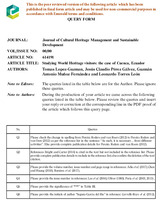Studying World Heritage visitors: the case of Cuenca, Ecuador
Autor
López-Guzmán, Tomás
Pérez-Gálvez, Jesús C.
Muñoz Fernández, Guzmán Antonio
Torres León, Leonardo
Editor
EmeraldFecha
2018Materia
Cultural tourismCultural heritage
World Heritage
Historic cities
Site management
METS:
Mostrar el registro METSPREMIS:
Mostrar el registro PREMISMetadatos
Mostrar el registro completo del ítemResumen
Purpose – The purpose of this paper is to explore the existing relations between three fundamental constructs (motivation and satisfaction) and the type of travellers in a World Heritage Site (WHS) tourist destination, the city of Cuenca (Ecuador).
Design/methodology/approach – The methodology used consisted of a fieldwork to determine the motivations and satisfaction of the visitor in the city of Cuenca, and then their segmentation.
Findings – The relationship between the study of motivation and satisfaction is a fundamental element in the development of WHSs. Similarly, it presents four different types of tourists obtained from their motivational variables. The results show the existence of three motivational dimensions for visiting Cuenca: cultural, circumstantial and convenience. Similarly, and using the motivation scenarios, four types of visitor have been identified: a cultural tourist, a cultural convenience tourist, a cultural circumstantial tourist and an alternative tourist.
Practical implications – The principal practical application of this research is to contribute to understanding the motivations of the visitors in relation to the city of Cuenca as a WHS for the purpose of designing tourist and cultural products that better satisfy the needs of the tourists and that, at the same time, are compatible with the sustainable management of the destination.
Originality/value – This paper seeks to contribute to promoting the relationship between tourism, sustainability and heritage in Latin America.

